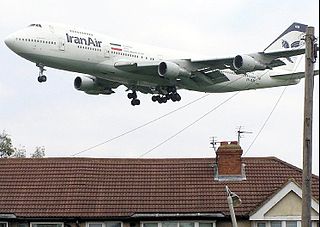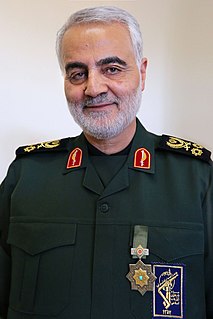
Iran and the United States have had no formal diplomatic relations since April 1980. Pakistan serves as Iran's protecting power in the United States, while Switzerland serves as the United States' protecting power in Iran. Contacts are carried out through the Iranian Interests Section of the Pakistani Embassy in Washington, D.C., and the US Interests Section of the Swiss Embassy in Tehran. In August 2018, Supreme Leader of Iran Ali Khamenei banned direct talks with the United States.

Sayyid Ali Hosseini Khamenei is a Twelver Shia Marja' and the second and current supreme leader of Iran, in office since 1989. He was previously President of Iran from 1981 to 1989. Khamenei is the longest serving head of state in the Middle East, as well as the second-longest serving Iranian leader of the last century, after Shah Mohammad Reza Pahlavi.

The Islamic Revolutionary Guard Corps is a branch of the Iranian Armed Forces, founded after the Iranian Revolution on 22 April 1979 by order of Ayatollah Ruhollah Khomeini. While the Iranian Army defends Iranian borders and maintains internal order, according to the Iranian constitution, the Revolutionary Guard (pasdaran) is intended to protect the country's Islamic republic political system. The Revolutionary Guards base their role in protecting the Islamic system as well as preventing foreign interference and coups by the military or "deviant movements".

The United States has since 1979 applied various economic, trade, scientific and military sanctions against Iran. U.S. economic sanctions are administered by the Office of Foreign Assets Control (OFAC), an agency of the US Treasury Department. Currently, US sanctions against Iran include an embargo on dealings with the country by the U.S., and a ban on selling aircraft and repair parts to Iranian aviation companies.

Qasem Soleimani was an Iranian military officer who served in the Islamic Revolutionary Guard Corps (IRGC). From 1998 until his assassination in 2020, he was the commander of the Quds Force, an IRGC division primarily responsible for extraterritorial and clandestine military operations. In his later years, he was considered by some analysts to be the right-hand man of the Supreme Leader of Iran, Ali Khamenei, as well as the second-most powerful person in Iran behind him.

Ahmad Kazemi was an Iranian commander in the Islamic Revolutionary Guard Corps and one of the most notable commanders in Iran–Iraq War.

The Supreme Leader of Iran, also referred to as Supreme Leader of the Islamic Revolution, but officially called the Supreme Leadership Authority, is the head of state and the highest political and religious authority of the Islamic Republic of Iran. The armed forces, judiciary, state television, and other key government organizations such as Guardian Council and Expediency Discernment Council are subject to the Supreme Leader. The current lifetime officeholder, Ali Khamenei, has issued decrees and made the final decisions on the economy, the environment, foreign policy, education, national planning, and other aspects of governance in Iran. Khamenei also makes the final decisions on the amount of transparency in elections, and has dismissed and reinstated presidential cabinet appointees.

Hossein Dehghani is a former IRGC air force officer with the rank of brigadier general and the former minister of defense of Iran. He was designated for the position by President Hassan Rouhani on 4 August 2013 and confirmed by the parliament on 15 August. He left the office on 20 August 2017.
The Ya-Ali is an air-launched cruise missile (ALCM) built by Iran. The missile was first unveiled on 11 May 2014 when Iranian leader Grand Ayatollah Ali Khamenei visited the Aerospace Force of the Army of the Guardians of the Islamic Revolution. According to Janes Defence, the missile has a jet engine inlet and possibly uses a version of the Toloue-4 turbojet Iran produces for its longer-range anti-ship missiles and it is reported to have a range of 700 km. On February 7, 2015, Iran's Deputy Defense Minister Mohammad Eslami announced that the missile could previously be launched from only Mirage type fighter planes but it can now be launched from every fighter plane that Iran owns. It is named after a Shi'i religious expression beseeching imam Ali. As an ALCM, the Ya-Ali is distinct from the ground launched cruise missiles (GLCMs) in the Houthi inventory. According to Jane's Defense Weekly, the Houthis may have used a Quds 1 GLCM in the Abha International Airport attack on 12 June 2019. This airport in southwestern Saudi Arabia is less than 200 km from the Yemeni border. The Iranian Ya-Ali has a much longer range due to being imparted with much more kinetic and potential energy when released from a fighter aircraft such as the Mirage type. The Houthis have no fighter aircraft in their inventory.

Jamal Ja'far Muhammad Ali Al Ibrahim, known by the kunya Abu Mahdi al-Muhandis, also spelled Mohandes, was an Iraqi commander of the Popular Mobilisation Committee (PMC). At the time of his death, he was deputy chief of the PMC.

Hossein Salami is an Iranian military officer with the rank of Major general, who is the commander-in-chief of the Islamic Revolutionary Guard Corps (IRGC).

The Office of the Supreme Leader of Iran, also known as the House of Leadership, is the official residence, bureaucratic office and principal workplace of the Supreme Leader of Iran since 1989.

The 2017 Tehran attacks were a series of two simultaneous terrorist attacks occurred on 7 June 2017 that were carried out by five terrorists belonging to the Islamic State of Iraq and the Levant (ISIL) against the Iranian Parliament building and the Mausoleum of Ruhollah Khomeini, both in Tehran, Iran, leaving 17 civilians dead and 43 wounded. The shootings were the first terrorist attacks in Tehran in more than a decade, and the first major terror attack in the country since the 2010 Zahedan bombings.

On 18 June 2017, under Operation Laylat al-Qadr, Iran's Islamic Revolutionary Guards Corps (IRGC) fired six surface-to-surface mid-range ballistic missile from domestic bases targeting ISIL forces in the Syrian Deir ez-Zor Governorate in response to the terrorist attacks in Tehran earlier that month. Next day, the IRGC published aerial videos recorded by the Damascus-based IRGC drones flying over the city during the operation, confirming that the missiles had successfully hit the targets with precision.

On 22 September 2018, a military parade was attacked by armed gunmen in the southwestern Iranian city of Ahvaz. The shooters killed 25 people, including soldiers of the Islamic Revolutionary Guard Corps (IRGC) and civilian bystanders. It was the deadliest terrorist attack in Iran since the Chabahar suicide bombing in December 2010.

The 2019–2021 Persian Gulf crisis is the ongoing state of heightened military tensions between the Islamic Republic of Iran and the United States and their allies in the Persian Gulf region. Starting in early May 2019, the U.S. began a buildup of its military presence in the region to deter an alleged planned campaign by Iran and its non-state allies to attack American forces and interests in the Persian Gulf and Iraq. This followed a rise in political tensions between the two countries during the Trump administration, which included the withdrawal of the U.S. from the Joint Comprehensive Plan of Action (JCPOA), the imposition of new sanctions against Iran, and the designation of the Islamic Revolutionary Guard Corps (IRGC) as a terrorist organization. In response, Iran designated the United States Central Command as a terrorist organization.
On 29 December 2019, the United States conducted airstrikes against Kata'ib Hezbollah's weapons depots and command centers in Iraq and Syria, reportedly killing at least 25 militiamen and wounding 55 more. The U.S. Department of Defense said the operation was in retaliation for repeated attacks on Iraqi military bases hosting Operation Inherent Resolve (OIR) coalition forces, particularly the 27 December 2019 attack on a Kirkuk airbase that left an American civilian contractor dead. Kata'ib Hezbollah, a Shi'ite Muslim militia which has links to Iran, denied any responsibility for the attacks.

The assassination of Qasem Soleimani, an Iranian major general, took place on 3 January 2020 when the United States launched a drone strike at Baghdad International Airport that targeted and killed Soleimani while purportedly on his way to meet Iraqi Prime Minister Adil Abdul-Mahdi in Baghdad. Soleimani was commander of the Quds Force, one of five branches of Iran's Islamic Revolutionary Guard Corps (IRGC), and was considered the second most powerful person of Iran, subordinate to Supreme Leader Ali Khamenei. Five Iraqi nationals and four other Iranian nationals were killed alongside Soleimani, including the deputy chairman of Iraq's Popular Mobilization Forces (PMF) and commander of the Iran-backed Kata'ib Hezbollah militia, Abu Mahdi al-Muhandis – a person designated as a terrorist by the U.S. and the United Arab Emirates (UAE).

On 8 January 2020, in a military operation code named Operation Martyr Soleimani, Iran's Islamic Revolutionary Guard Corps (IRGC) launched numerous ballistic missiles at the Ayn al-Asad airbase in Al Anbar Governorate, western Iraq, as well as another airbase in Erbil, in the Kurdistan Region, in response to the killing of Major General Qasem Soleimani by a United States drone strike. While the U.S. initially assessed that none of its service members were injured or killed, the U.S. Department of Defense ultimately said that 110 service members had been diagnosed and treated for traumatic brain injuries from the attack.

Ukraine International Airlines Flight 752 (PS752) was a scheduled international passenger flight from Tehran to Kyiv operated by Ukraine International Airlines (UIA). On 8 January 2020, the Boeing 737-800 operating the route was shot down shortly after takeoff from Tehran Imam Khomeini International Airport by the Iranian Islamic Revolutionary Guards Corps (IRGC). All 176 passengers and crew were killed.



















